Unesco: Seven reasons Wales has a new World Heritage Site
The slate landscape of Wales has become the latest site in the UK to be awarded World Heritage status by Unesco.
Slate from the quarries in Snowdonia, Gwynedd, are said to have "roofed the 19th Century world" as the product was exported around the globe.
But it doesn't stop there - have you ever spotted the landscape in your favourite Hollywood films?
Here we look at some of the reasons why the unusual landscape is worthy of the prestigious status.
'Huge impact on global architecture'
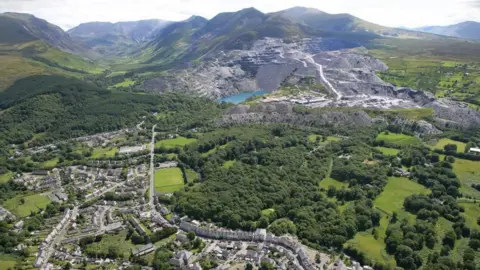 RCAHMW
RCAHMWBoris Johnson said the slate landscape of north-west Wales was "an area of remarkable uniqueness and breath-taking beauty" after it was announced by the UK government as its World Heritage Site nomination in 2018.
Slate has been quarried in north Wales for more than 1,800 years but during the Industrial Revolution demand surged as cities across the UK expanded with slate being widely used to roof workers' homes and factories.
The UK bid said, as well as the international demand for Welsh slate, between 1780 and 1940 the area of Gwynedd was also home to a number of "ingenious developments in quarrying and stone processing" and was a world leader in mountain railways.
Its landscape became the leading producer of slate during the 18th Century and by the 1890s, the industry employed just less than 17,000 people and produced 485,000 tonnes of slate a year.
 PA/Getty
PA/GettySlate industry expert Dr David Gwyn from the Nantlle Valley said the UK's application highlighted the way the landscape had contributed to a "significant stage of human history", bringing socio-economic changes.
"The slate quarries were described as the most Welsh of Welsh industries, the only major industry that throughout its history has been conducted in a language other than English in the British Isles," he said.
Luke Potter, assistant director of National Trust Cymru, said the bid, which had been 15 years in the planning, highlighted much more than the "remains of the slate industry".
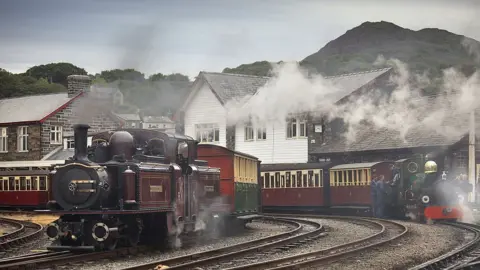 Getty Images
Getty Images"It's also about the culture that was reached in that, so the role the industry played with Welsh language with the communities, the money that flowed through this to then invest in north Wales itself," he told BBC Radio Wales.
The slate industry in north-west Wales had a huge impact on global architecture, with Welsh slate used on a number of buildings and palaces across the globe, including Westminster Hall, the Royal Exhibition Building in Melbourne and Copenhagen City Hall in Denmark.
But it has also had other notable moments too...
Site of one of the UK's longest strikes
Penrhyn Quarry was once considered to be the largest slate quarry in the world, employing 2,800 men, turning Bethesda into a town of 8,000 people.
 Getty Images
Getty ImagesIts owner held a grudge against his workers after losing his Parliament seat in 1880 so abolished a system of rate negotiation, which led to The Great Penrhyn Strike. It was one of the longest strikes in history, lasting three years from 22 November 1900.
Art hidden in quarry during World War Two
During World War Two, a quarry in Snowdonia was used to hide some of the world's most treasured paintings from the Nazis.
As Allied troops fled Dunkirk in 1940, a German invasion of the UK seemed inevitable - and prompted the National Gallery to take evasive action to protect its collection.
 Getty Images
Getty ImagesThis led wartime leader Winston Churchill to famously declare: "Hide them in caves and cellars, but not one picture shall leave this island."
This led to Manod Quarry in Blaenau Ffestiniog, Gwynedd being used as a temporary store as the cavernous space at the heart of the mountain - covered with hundreds of feet of slate and granite - was virtually impregnable to bombing. Plus its remote setting also helped keep the mission top secret.
From Hollywood Hills to Snowdonia mountains
Scenes of some famous blockbusters have been filmed in Wales - such as Harry Potter and Robin Hood - and Dinorwig Quarry was the backdrop for Clash of the Titans, featuring Liam Neeson, and scenes from Tarzan with Samuel L Jackson.
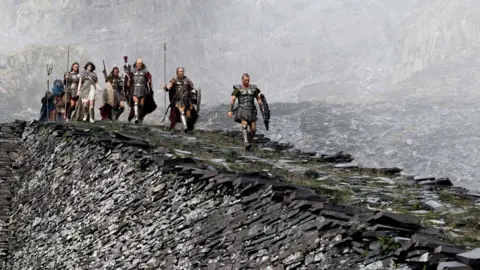 Alamy
AlamyThe second biggest quarry in the world may be a true Welsh landscape but it can also be transformed to look like almost anywhere - including Greece!
There's electricity in them thar hills
Dinorwig Power Station was regarded as one of the world's most imaginative engineering and environmental project when it was fully commissioned in 1984.
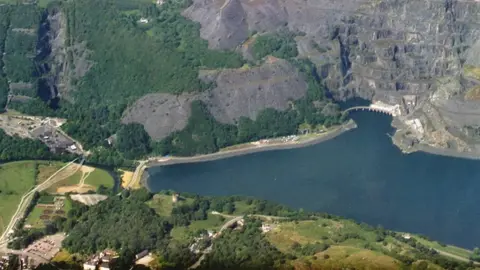 Geograph | Chris
Geograph | Chris The £425m hydro-electricity plant, known as Electric Mountain, comprises of 16km of underground tunnels deep below Elidir mountain in Snowdonia - and its six powerful generating units make it one of the largest power stations of its kind in Europe.
Every second, each turbine receives enough water to make 15 million cups of tea and can supply a maximum power of 1,728-megawatts.
Bombs and explosives hidden in quarry
Glan Rhonwy slate quarry, which is about the size of two football pitches, was used as a secret munitions store during World War Two and it used to store captured German nerve gas.
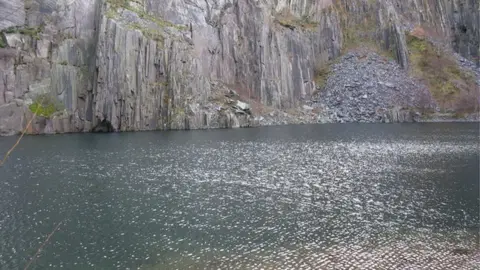 Eric Jones | Geograph
Eric Jones | GeographThe area at Llanberis was later was used to dispose of old bombs, bullets and grenades before the former RAF ammunitions store was cleared in the 1970s.
Did Thomas The Tank Engine help UK's Unesco bid?
One of the best loved children's train cartoons was partly thanks to one mini railway in Gwynedd.
 Talyllyn Railway
Talyllyn RailwayThe creator of the Thomas The Tank Engineer series was The Rev W Awdry and his stories were inspired by his experiences as a volunteer at Talyllyn Railway in the 1950s.
For almost a century the narrow gauge railway hauled slate through Snowdonia before it became the world's first preserved railway in 1951.

- EXPLORE WALES FROM HOME: Join Iolo Williams for a guided tour of Pembrokeshire’s hidden gems
- WALK THE WELSH COASTAL PATH: 900 miles of the most picturesque coastal locations to visit this summer

